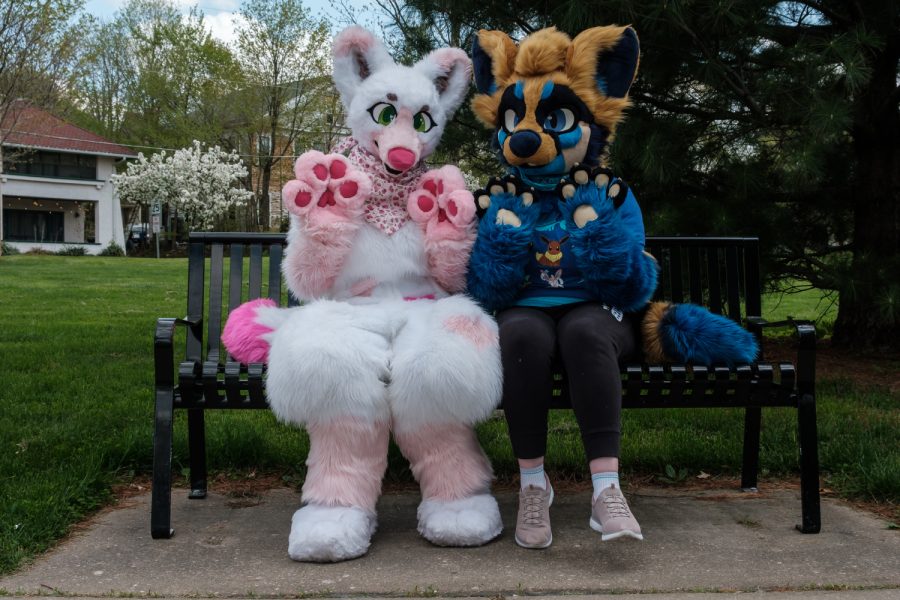Fur of the moment: The Furry community in Iowa City
The Furry fandom is a growing community, nationally and locally. And there’s nothing fuzzy about it.
Vixie Valentine (left) and Salted Caramel (right) pose for a portrait in College Green park in Iowa City on Monday, May 6, 2019.
May 8, 2019
What do you think of when you think of Furries?
The Furry fandom is a wide community of those who are a fan of anthropomorphic animals, who create fan art or dress up in full size, fluffy costumes as animals of their own design, typically known as a Furry persona, or Fursona. According to Inverse.com, the community has been steadily on the rise since the ’90s.
Ranker.com cites the conception of the Furry fandom beginning in the 1980s, growing out of sci-fi and animé conventions. The Furry community is similar to the cosplay community — one that also thrives at and grew out of conventions — in many senses; people will buy or build their costumes and dive deep into the characters that they create.
Locally, the University of Iowa club Anthropomorphic Furry Friends has just finished its first year as a student organization. UI sophomores Nicole Lange and Bill Hollatz run the organization, and this past weekend, they hosted a Furry picnic in City Park, inviting friends of the fandom to eat and mingle. It was the first meet-up that the organization has hosted.
For some members of Furry fandom, their interest in the community began in their early teen years and was sparked by animal-centric media.
“For me, it was really Pokémon that got me in to these animal characters,” Lange said. “Also, I read a lot of animal stories as a kid, and seeing all the art that people made got me interested in it, and making my own suit seemed really cool.”
UI sophomore Shelby Hornaday, a member of the club, had similar beginnings.
“Mine also probably started when I found out about Pokémon,” Hornaday said. “I mean I didn’t really join the Furry fandom until I was like, 13.”
Hollatz cited the Disney film Zootopia and indie game Undertale as what got him interested in the Furry community.
For Lange, building her own fursuit and bringing her Fursona to life was a fairly recent endeavor, beginning early this year and spending two months crafting her costume. Her Furry alter-ego is Vixie Valentine, an Arctic fox with white and pink fur, large, green animé-like eyes, and a fluffy tail.
“I settled with Vixie … I’ve had her in my head, just a fox character, for years and I actually got her down on paper just last summer, and then made her,” she said. “I picked an Arctic fox because I like foxes, and I like Arctic foxes more because I feel like I connect to them. She has a Valentine theme because my birthday is right next to Valentine’s Day.”
While Lange and Hornaday both have fursuits, they are not required for someone to be considered a Furry, Lange said. Fursuits are typically crafted out of faux fur, fabrics, plastic, and foam.
Hollatz said one of the major misconceptions about the community was that everyone who is a Furry has a fursuit. Hollatz himself does not own a fursuit of his own, but does have the Fursona of Lokahi, a red panda.
According to the Anthropomorphic Research Project, a team of researchers examining the Furry community, only 15 percent of Furries surveyed had their own fursuits. Many wear partial pieces or just Furry accessories, such as a tail or paws.
“Fursuits are very expensive, and they can be tough to maintain,” Hornaday said.
Prices range for fursuits, and partial pieces, depending on the maker. For popular manufacturers such as Lemonbrat, partial pieces typically go for nearly $1,000, and full suits can range into the thousands.
“I personally made mine just because I didn’t want to spend a lot of money,” Lange said. “You can either buy a full suit from someone or even just a head or just paws.”
Lange and Hornaday both said they typically wear their suits to conventions, either Furry cons, such as Midwest Fur Fest, the world’s largest Furry convention that takes place outside of Chicago, or to animé cons.
“Sometimes I throw her on at home to get pictures if I have something I want to get a picture of her with,” Lange said. “I’d say usually I don’t just throw her on for funsies, because especially if I try to put on full suit, that takes a bit to get into because I have padding to put in.”
Similarly to cosplay, costumes are typically worn by members of the fandom at conventions or for personal photos and social media.
“I usually wear mine to cons, or on Halloween, or at home, for just like pictures,” Hornaday said. She also wears them to post on the social-media app tiktok, under the user @saltedcaramelfen.
Along with every Furry having a suit, a common misconception perpetuated in the media is that the Furry community is rooted in something sexual. However, Lange said, this is not the case.
“It’s definitely not [sexual] for everyone. I mean it’s a thing, but it’s not any more of a thing than it is in any other community I would say,” she said. “It’s something people do, obviously it’s going to bleed into their interests, but it’s definitely not something everyone does.”
An article debunking Furry myths by Vox cited an episode of the television show “30 Rock” and a 2007 article by Vanity Fair as examples of the media oversexualizing the Furry community.
“I feel like the reason that misconception exists is that Furries are more OK with that kind of stuff, even if they’re not into it, so it’s just more visible than in other communities, maybe,” Hollatz said.
Hollatz and Lange both said the Furry community was a welcoming one, which made them feel less anxious.
“Putting on a big animal costume lets me feel a little less anxious around other people. It helped me open up,” Lange said. “I’ve made a lot of friends — I would still have no friends in college if I didn’t have Furry, I don’t think, because I met [Hollatz] through the ‘Furry trash’ pin on my backpack. It’s a nice, friendly, safe space.”
Hollatz agreed.
“I don’t even have a suit, and I still feel less anxious around Furries,” he said.
Hornaday noted the inclusiveness that comes with the Furry community.
“It’s a very inclusive and free kind of community,” Hornaday said. “There are a lot of LGBT people in the furry community, so there’s a lot of acceptance of that.”
According to furscience.com, the website run by the Anthropomorphic Research Project, only around one-third of Furries identify as exclusively heterosexual. The website also states that Furries use the community to bolster social interaction, as well as creativity, something Lange indicated was a big draw to the fandom.
“I like how creative it is, seeing people make these characters and then bringing them to life, either with their art or by actually building them is really cool,” she said. “You can have just a regular animal; you can also just combine animals and have whatever you want.”






